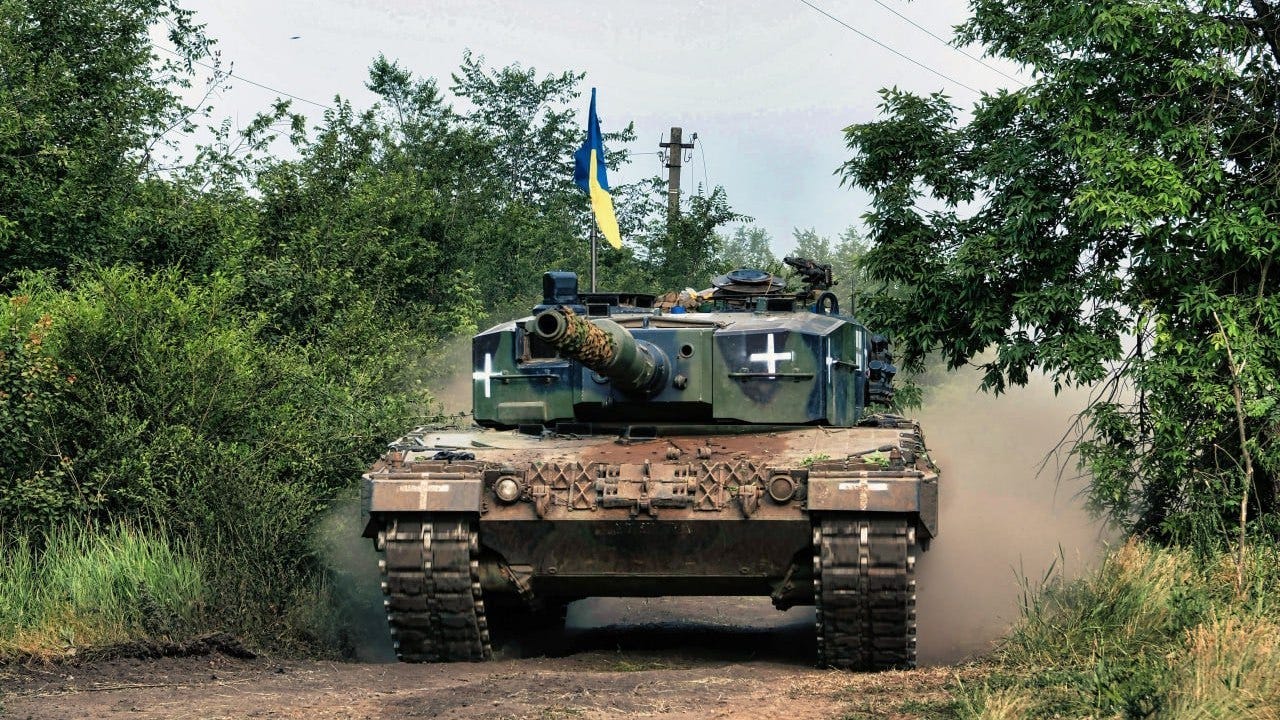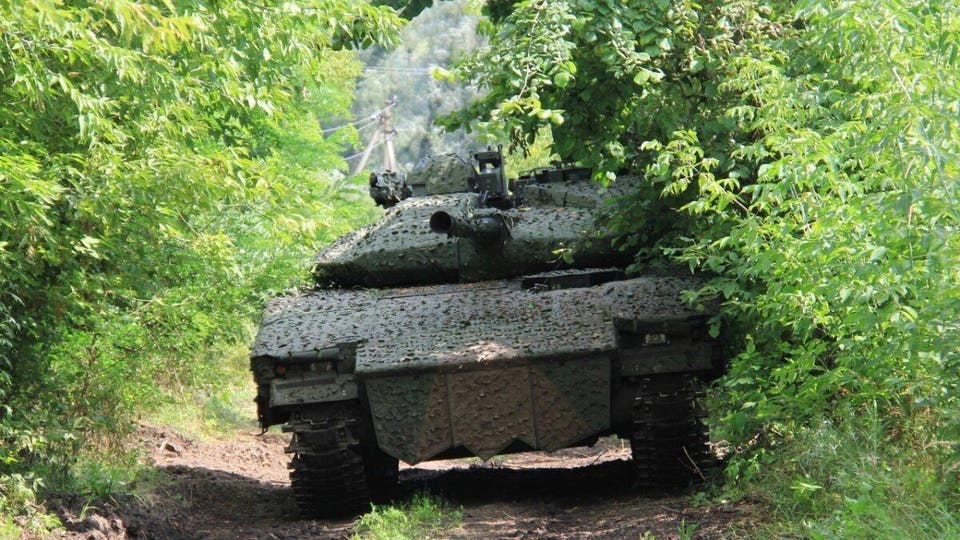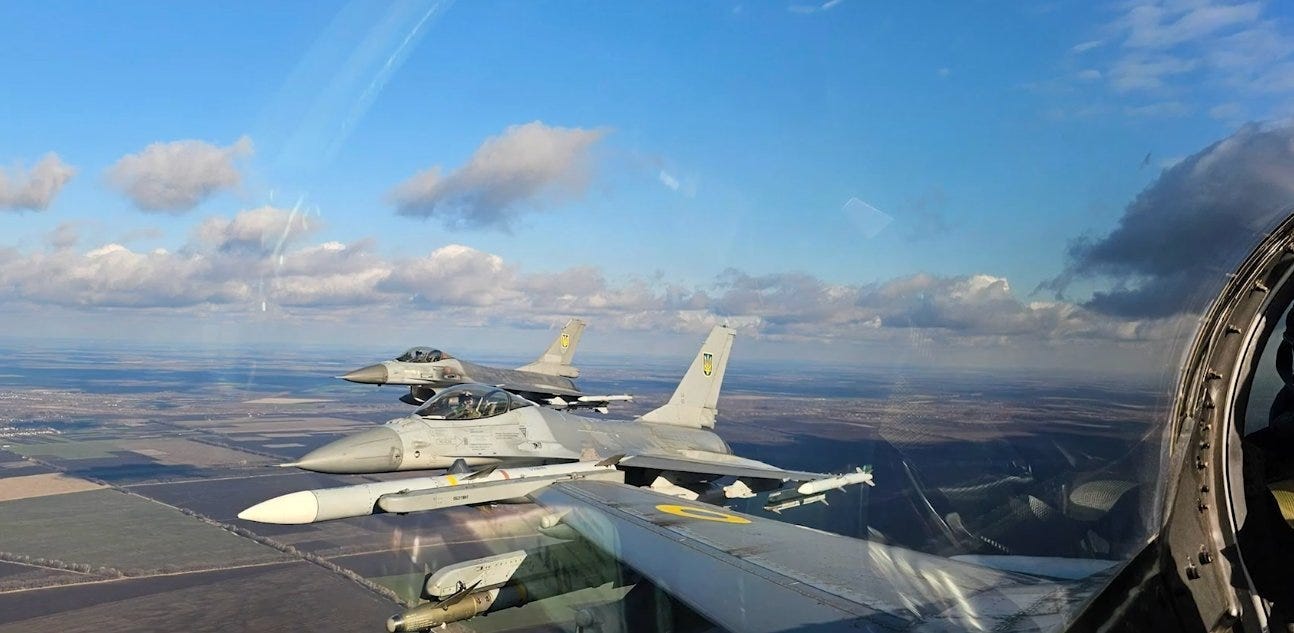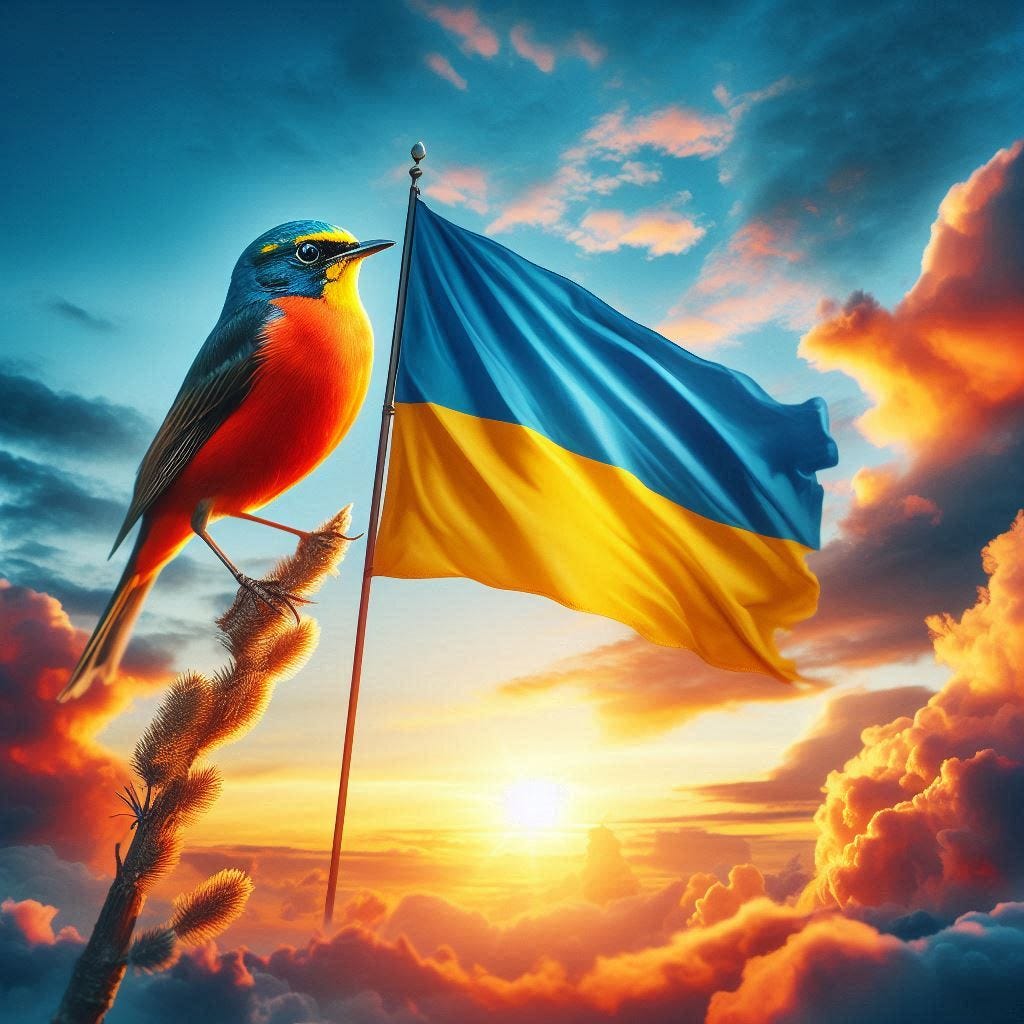The Nightingale's Arsenal – Modern Ukrainian Weapons
A selection of weapons and weapon systems with which Ukraine battles against Russia.
NOTE: the Nightingale is a significant symbol of Ukrainian culture and folklore, representing beauty, talent, and the spirit of the Ukrainian language.
Hence, it’s use and reference in these articles.
Ukraine now deploys a mix of eastern, western and home grown weapons. It’s drone army, meantime, is unmatched and huge; deploying increasingly sophisticated drones in the air, on land and at sea.
Whilst logistically it must require considerable effort to maintain such a diverse variety of weapon systems, these are good weapons; even the oldest of their variants have seen extensive service and are yet another capability added to Ukraine's diverse range.
This article is intended to introduce some of those weapons. Like the Russian weapons article I wrote months ago, it will not list every single weapon but instead will introduce a few choice examples.
I hope this is useful.
General principles
As with my other article on Modern Russian Weapon Systems, this article requires a few general principles to be outlined before we dive in:
Soviet legacy = Despite Western aid, a considerable portion of weapons and weapon systems used by Ukraine continue to be Soviet legacy systems. T-64 tanks, Kalashnikov rifles, a variety of rocket and artillery pieces. Never mind the extensive stocks of Russian weapons captured from Ukraine’s enemy; so much so that at one point Russia was actually Ukraine's main supplier of weapons! As such, a lot of Ukrainian soldiers are still training and using older equipment or modern Russian equipment. These carry the advantage of proven ruggedness, but also carry the disadvantage of not being nearly as concerned with crew protection and survival, and not as adapted to modern threats, especially drones.
Western variety = like a mini-NATO, Ukraine has been supplied with a huge variety of weapons and equipment from Western backers. Tanks from Germany, rifles from Hungary (yes, even Hungary), shell's sourced by the Czech republic. The list goes on. This creates a logistical head-arch (or challenge, depending on how you look at it) but provides Ukraine with a vast array of different capabilities and different systems who have particular advantages in some areas. The M777 artillery piece for example is excellent for long range fires, but is a towed-weapon system so must be carefully positioned either in a hardened location to protect it from drones, or in an area where it can be easily moved away again.
Home Grown industry = as the war has dragged on, Ukraine has rapidly expanded its home-grown defence industry. Already capable of producing the likes of T-64 tanks, its defence industry has expanded into critical areas like cruise missile production, such as the now infamous Moskva-ship-killer ‘Neptune', to its own mobile artillery platform the ‘Bohdana’ and of course, its vast ‘drone army' that now manufactures an astounding 100 different types of air, sea and land drones.
What was available at the time = When the full scale invasion started (remembering the actual war started in 2014), the equipment provided to Ukraine was mostly ‘defensive' in nature and limited. The West, particularly America, expected Ukraine to become the ‘Afghanistan of Europe' for the Russians. Instead, Ukraine's defence made the war much more of a peer-to-peer conflict. Taken off guard, original provision to Ukraine consisted of lighter weapons, then only scaled up to whatever NATO could afford to send. Old M113 APC's, Anti-aircraft missiles, old legacy soviet equipment. Only later on in 2023 did more high-end kit really come to the fore such as Leopard tanks, Patriot missile systems and HIMARS rockets. This has resulted in not just the vast array of weapons and weapon systems, but also a need to constantly reassess what is available at the time. The Ukrainian 2023 counter offensive had to make-do with what western equipment was available but not always in the quantities it would like or need. This was in addition to unforeseen challenges such as in 2024, with the 6-7 month lack of United States aid.
Drone Masters

Whilst UAV’s and drones have been around for decades, it is the War in Ukraine that has seen a massive increase in both their capabilities and quantities. Huge numbers of air, land and sea drones are now deployed across Ukraine.
On the Ukrainian side, here are just a few noteworthy variants.
FPV drones
FPV drones have been available for quiet some time, but it is only in the Ukraine that there use hasn’t just become wide spread, but essential for offensive and defensive operations.
Ukraine has dozens of organisations both government funded and volunteer based providing FPV drones to front line troops.
Able to fulfil a variety of roles these weapons provide not just powerful strike capabilities against troops and equipment, but also propaganda and intelligence value in the videos they produce.
Recon Drones
Ukraine deploys a variety of recon drones at tactical and strategic layers
At a squad based, tactical level it is often the humble DJI Mavic drone, used by both aides that carries the lions share of observation requirements of Ukrainian infantry squads.
The Shark UAS drone is the larger more capable drone for commanders to use to observe.
Other types of drone
Bomber drones are larger versions of grenade-dropper drones, able to drop heavier ordnance.
In Ukrainian service the ‘Vampire’ drone is one of the more well known.
Dubbed ‘Baba Yaga’ by the Russians (translates as ‘Boogie Man’) this drone is hard to jam, very quiet and able to operate effectively at night using a thermal imaging camera.
Due to Russian troops typically being less well equipped with night vision gear, spotting and stopping a Vampire drone is hard.
As well as airborne drones, Ukraine has deployed land based drones.
Indeed it is thought Ukraine is the first country to have successfully conducted an attack solely using land and air based drones, with the only direct infantry involvement that of consolidating captured areas.
Naval drones
Ukrainian Naval drones have been particularly effective and have been a constant and brutal threat to Russian surface ships.
At first they were simply re-constructed speed boats packed with explosives and controlled via a digital camera and often times, a star link terminal.
Today however, they are an entirely different and more deadly machine.
The most famous now is the line of Magura drones that provide every conceivable naval warfare requirement, including even having the capability to mount lasers and carry a supply of their own FPV drones.
More is to follow, with the ‘Katran’ another naval drone on its way.
Artillery

The Towed M777 artillery piece is prehapes one of the unsung heros of the war in Ukraine. An American produced standard towed artillery piece, a fully trained crew can setup and fire the M777 in minutes, before packing it up again and moving out.
Recently ‘shoot and scoot’ has become less effective due to so many drones operating, so heavily camouflaged and defended towed artillery pieces are actually preferred by both sides. Hence the M777 and the like will continue to see plenty of war in the future.
The domestically produced ‘Bohdana’ is a good example of swift innovation, construction and deployment. Whilst good deployment and tactics are required to get the best out of them (and avoid drones), they are effective truck born artillery carriers. Ukraine claims it can produce up to 40 of these vehicles a month.
Tanks

Old it might be but the Leopard 1 is still a good tank .
Speedy, with excellent reverse gears (essential for manoeuvring on the battlefield) it’s upgrades over the years have improved it’s accuracy and night fighting ability.
Whilst less technologically advanced than other more modern western tanks, it’s still vastly superior to the old T-55 and T-62 tanks increasingly fielded by Russia. It’s main let down is it’s armour plating; the tank was built for speed, so must be carefully deployed.
Perhaps the most common of modern NATO tanks, the Leopard 2 has good armour, speed, gun system and access to plenty of good logistical backup given it is a tank still in production and widely produced. Whilst its introduction to the conflict was not impressive (numerous variants were destroyed by Russian minefields and artillery strikes in the 2023 counter offensive) it is still an excellent tank.
Leopard 2’s have been able to outshoot their Russian opponents in the likes of ambushes and counter attacks utilising their better accuracy and targeting systems to the maximum. Despite using a manual loader, the tank appears to be capable of maintaining an exceedingly high rate of fire; this seems to be down tanks internal lay out, as well as both the professionalism of the Ukrainian loaders and their passion.
However, like any tank the Leopard 2 has it’s problems. Issues seem to be the tanks complexity to both operate and maintain.
Whilst only a small number of Challenger 2 tanks have been given to Ukraine, they have proven themselves formidable opponents for Russia.
The challenger 2 has been praised for it’s thick armour and long range gun and targeting ability.
However, it’s weight has been a problem, particularly during the winter when mud is a common issue across Ukraine’s battlefields.
Then there is the M1 Abrams; American armoured muscle.
It’s advantage is it’s good armour, gun system, night vision and crew survivability. It may be 1980’s vintage but it’s a proven old war horse.
It’s negative points are often logistical; this tank uses a different engine and fuel supply to other vehicles; specifically a gas turbine engine. It also needs a lot of that fuel.
Sadly many of the small number of these types of tank provided to Ukraine have been destroyed.
IFV’s – Infantry Fighting Vehicles

As stated earlier Ukraine still uses a lot of various versions of the BMP-1 , BMP-2 and a small number of captured BMP-3’s.
Increasingly though it is western infantry fighting vehicles that are deployed in growing numbers as NATO and Western governments seek to enhance Ukraine’s combat strength.
Marder IFV for example is a German made infantry fighting vehicle. Extensive numbers of this agile and well armed infantry fighting vehicles are used on the front line. With excellent speed and a 20 millimetre cannon, the Marder performs its required tasks efficiently and effectively.
The Bradley infantry fighting vehicle from America in the meantime, has become something of a poster boy for the Ukrainian military. This highly effective weapons system has powerful armour and formidable weapons packages. Wes O’Donnell has written an excellent article on this vehicle.
The most modern of the IFV's deployed to Ukraine today though, is the formidable CV-90. CV stands for ‘Combat Vehicle' and this Swedish IFV is combat ready in every way imaginable.
Its armour is often covered in ‘Barracuda’ camouflage nets which reduce the vehicles heat signature, making them hard to detect, especially at night. At the same time it has the best Night Vision equipment and a powerful and adaptive cannon. This makes this advanced IFV at home in night-time ops, where it dominates.
One must also not forget the home-grown addition to Ukraine’s forces, the BTR-4. This wheeled, as opposed to tracked, infantry fighting vehicle has been every bit as effective as the Russian equivalent, the BTR 82.
Fighter jets

The F-16’s have been very busy in Ukraine, performing an enormous variety of missions alongside legacy MIG-29’s And SU-27's. Sadly it is known that three F-16c’s have been lost in the year since they were introduced, but despite their relatively small numbers they have certainly had an impact on the air war increasingly used to supplement Ukraine’s air defences in the interception of drones and cruise missiles.
The French Mirage 2000 appeared as a surprising addition to Ukraine’s fighter compliment. Not a great deal is known about what missions The Mirage 2000s have flown but they have been undoubtedly active. it is suspected that they are performing close air support missions, alongside Ukraine’s SU-25’s. How many have been delivered, or will be delivered, is not being disclosed.
The future
I’ve not covered everything in this article; you’ll note a lack of reference to small arms, long range missiles and the Navy.
I may cover these and other aspects in a future article.
I hope this has been an interesting read in the meantime and a good primer on Ukrainian weapons.





Incredible how Ukraine turned logistical chaos into an advantage. What stands out isn’t just the gear, but the speed of adaptation. Drone warfare, rapid prototyping, even improvised naval drones; it’s not just defense anymore, it’s innovation at war-speed.
Makes you wonder: if Ukraine can rewire its defense base mid-war, what’s stopping us from doing the same in peacetime?